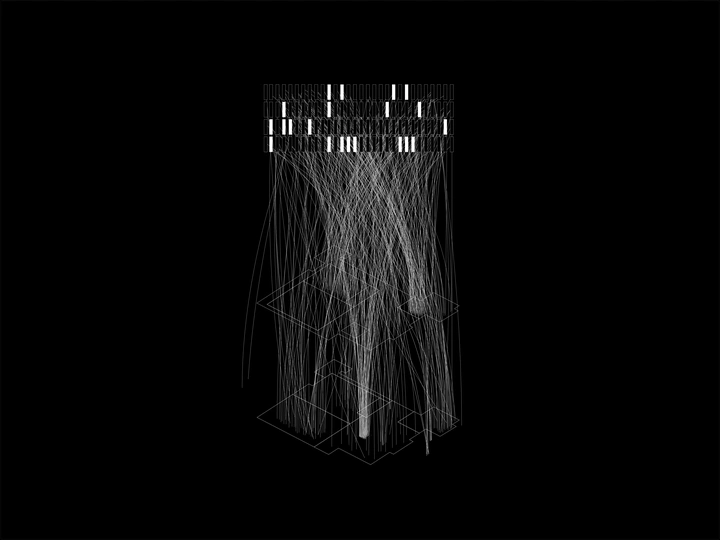Guiding the Transition

Ekaterina Miroshnichenko
Franz Ocana
fractal is a young spatial collective founded by Hana Gjikolli (Kosovo), Franz Ocaña (Colombia), and Katja Miroshnichenko (Russia). We met during our Master’s studies at Hochschule Wismar, Germany, where we discovered a shared sensitivity to spatial, political, and cultural conditions. Our dialogue evolved into a creative and personal bond united by shared values and an intuitive approach to space—marked by emotional depth, critical reflection, and close attention to the existing. Though our methods are personal, they resonate to form a collective voice that is sensitive, deliberate, and open-ended.
As recent graduates in architecture and interior design, we are drawn to existing spaces—especially abandoned, layered, and imposing ones. Our Master’s theses form the conceptual foundation of our practice. Hana’s thesis, Guiding the Transition, explored the Palace of Youth and Sports in Prishtina through interviews and public engagement. She developed the concept of enablers: spatial interventions that awaken dormant potential by listening to emotional and political layers within abandoned structures. Franz’s thesis, Rethinking the E-T Block, introduced the Act of Looking—a methodology of spatial reading through attentive observation, treating all existing elements as vital resources that break hierarchies in architectural conservation. Katja’s thesis, In Between, proposed a creative retreat and Artist-in-Residence in a former Grand Hotel in Schwerin, approaching transformation as a negotiation between past and future through intuitive, layered gestures.
As fractal, we see architecture as a political and social act. Our work activates overlooked spaces through listening, dialogue, and shared authorship. By combining Hana’s enablers, Franz’s observation, and Katja’s layering, we create a practice rooted in care, complexity, and a refusal to impose. For us, architecture is a collective act of attention and transformation.
To understand the Palace of Youth and Sports in Prishtina, we propose to listen as an architectural act, to see conflictual coexistence as a valuable spatial tool, and to embrace transformation as a politically shared process.
Our project builds on Hana’s thesis, which introduces enablers: spatial interventions that arise from deep listening to a site’s material, emotional, and political conditions. Enablers do not impose; they activate what is already present. Franz’s thesis contributes the Act of Looking, a method of spatial interpretation through careful observation. Katja’s work explores transformation as negotiation, allowing past and future to coexist through layered interventions.
As part of the Kosovo Architecture Festival, we propose a participatory workshop in the Palace. Using 120+ memories collected in Hana’s research, we invite participants to reinterpret and remap the building.
The workshop unfolds in three stages:
1. Listening through memory: sharing and reflecting on collected stories
2. Observing through mapping: documenting (forgotten) spatial fragments
3. Transforming through making: co-creating spatial enablers that reflect collective perception
These temporary enablers — possibly mobile panels for shared stories, benches for mediated conversations, or quiet corners for immersive observation — are co-designed with participants and the building itself. Installed temporarily throughout the Palace, they serve as tools for reflection, dialogue and presence.
Instead of offering a singular vision, the project embraces polyphonic authorship—valuing contradiction, coexistence, and negotiation. All outcomes would then be curated in a booklet by fractal as open-ended propositions for transformation.
Through this collective act we ask:
Can this enable a new way of relating to the building’s future – one rooted in shared agency and imagination rather than imposed solutions?